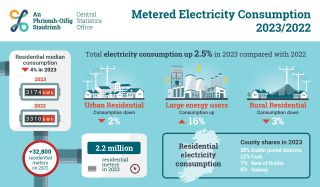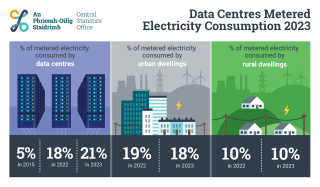Metered Electricity Consumption 2023

The latest Central Statistics Office data on electricity consumption shows that large Energy Users accounted for 30 per cent of Metered Electricity Consumption in 2023, more than urban residential and rural residential combined. The amount of electricity consumed by large energy users increased by 16 per cent between 2022 and 2023 and has increased by over 150 per cent since 2015. As the amount of electricity consumption by large energy users continues to increases annually, this raises issues regarding the amount of renewable energy that Ireland can generate, and who will be the main consumers of this energy.
Metered electricity consumption Ireland 2023 - key findings
The latest data from the CSO on metered electricity consumption in 2023 gives us an indication of who the main consumers of electricity are, and where these consumers (residential or non residential) are based. While residential electricity consumption fell between 2022 and 2023, non-residential electricity consumption increased during this period.
- Total metered electricity consumption in 2023 was 30,600 GWh (gigawatt hours) in 2023, an increase of 2.5% compared with 2022.
- Large Energy Users used 30% of metered electricity consumption in 2023 – more than the combined total of Urban Residential (18%) and Rural Residential (10%).
- Consumption by large energy users increased by 16% between 2022 and 2023 and by 151% between 2015 and 2023. The peak demand period for very large energy users occurred between 1pm and 3pm.
- Large Energy Users comprise a small number of customers such as the largest data centres and the highest electricity consumers in other business sectors such as IT and cement manufacturing.
The consumption by Urban Residential and Rural Residential decreased by 2% and 3% respectively between 2022 and 2023. Non-residential consumption increased by 4% over the same period. - Metered electricity consumption by stand-alone Electric Vehicles (EV) charge points rose by 38% in 2023
- Dublin Postal Districts had the highest proportion of residential consumption in 2023 at 18%, followed by Cork (12%), Dublin County (7%), Galway (6%) and Kildare (5%).
- Median residential electricity consumption was down in every county in 2023 compared with 2022. Donegal, Leitrim and Mayo had the lowest median residential consumption in 2023. Kildare had the highest figure.
Metered Electricity Consumption by Data Centres 2023
The Central Statistics Office also gives a breakdown of electricity consumption by data centres increased in 2023. The larger data centres make up a large proportion of the large energy users in Ireland. The CSO findings show that electricity consumption by data centres increased by 20 per cent between 2022 and 2023.

Since 2015, the percentage of total metered electricity consumption by data centres has increased steadily from 5 per cent to 21 per cent in 2023.
| Table 1 Metered Electricity Consumption 2015-2023 | ||||
| Gigawatt hours | % of Total | |||
| Year | Data Centre | Other Metered Customers | Total | % Data Centre |
| 2015 | 1,238 | 23,362 | 24,600 | 5 |
| 2016 | 1,480 | 23,876 | 25,356 | 6 |
| 2017 | 1,760 | 23,966 | 25,725 | 7 |
| 2018 | 2,180 | 24,550 | 26,730 | 8 |
| 2019 | 2,488 | 24,017 | 26,505 | 9 |
| 2020 | 3,028 | 24,028 | 27,056 | 11 |
| 2021 | 4,010 | 24,496 | 28,506 | 14 |
| 2022 | 5,270 | 24,554 | 29,824 | 18 |
| 2023 | 6,334 | 24,246 | 30,581 | 21 |
The substantial increase in electricity consumption by large energy users and in particular data centres means that meeting our targets on reduced emissions from energy and increased generation of renewable energy will be difficult to achieve, particularly is we continue to pursue a policy of data centre expansion. The additional subsidisation costs for data centres (including data centres consumption of renewable energy) are in part borne by residential and other commercial customers. The challenges of pursuing a policy of data centre expansion whilst setting ambitious climate goals was explored in detail by Dr Patrick Bresnihan in our podcast series. As a very first step towards addressing this type of policy coherence Social Justice Ireland proposed that Government in recent Budgets reorganise the PSO levy according to average demand. This would be a first step to ensure that Data Centres make an appropriate contribution to Ireland’s renewable energy targets.
